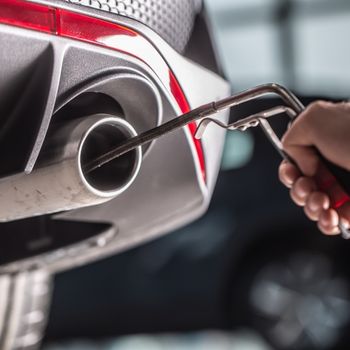 Your car’s exhaust system is designed to help reduce the amount of carbon monoxide generated and subsequent poisoning risks. Defects, including leaks from rusted components or a damaged catalytic converter, interrupt this process. As a result, you may be exposed to concerning amounts of carbon monoxide through the heating and cooling system or diverted directly into the cabin.
Your car’s exhaust system is designed to help reduce the amount of carbon monoxide generated and subsequent poisoning risks. Defects, including leaks from rusted components or a damaged catalytic converter, interrupt this process. As a result, you may be exposed to concerning amounts of carbon monoxide through the heating and cooling system or diverted directly into the cabin.
Understand how these scenarios can happen and what you can do to stay protected.
How Cars Reduce Carbon Monoxide Emissions
The combustion process generates high amounts of carbon monoxide – over 30,000 parts per million (ppm) for the typical vehicle. To control exposure, cars are equipped with a catalytic converter, which combines oxygen with carbon monoxide to form carbon dioxide.
Once the substance passes to the exhaust manifold, the amount of carbon monoxide is reduced to about 1,000 ppm. Without this process, your car can release 30,000 ppm or higher concentrations of carbon monoxide from the tailpipe.
Exhaust leaks interrupt this process and divert the carbon monoxide generated by combustion. Specifically, a leak often causes a percentage of carbon monoxide to escape before it’s had a chance to reach the catalytic converter. When this occurs, it may enter the car’s cabin through holes in the body, window, doors or the HVAC system.
How Carbon Monoxide Can Enter the Cabin
We often associate carbon monoxide poisoning with a running car left inside an enclosed space, like a garage. However, this substance can enter the cabin as a result of a damaged or defective exhaust system, driving with the trunk or tailgate open, holes in the body panel or floor, or exhaust diverted from the tailpipe through the car windows.
These situations can arise from one or more of the following factors.
Combustion Process Defects
This scenario starts with a poorly maintained or damaged engine that’s generating an above average amount of carbon monoxide, then diverts unburned fuel to the exhaust. These factors can impact how the catalytic converter performs. Without sufficient oxygen, a hazardous amount of carbon monoxide travels through the exhaust system.
Rust and Corrosion
Corrosion occurs within your car’s exhaust system and body panels. Especially if rust goes unnoticed, the exhaust system, engine bay and body panels can develop holes that cause exhaust gases to enter the cabin. This may be due to a cracked exhaust manifold, which allows carbon monoxide to pass into the car from the engine bay, damaged seals causing gas to travel through the intake vent or a hole in the floor or side panel, causing carbon monoxide from the tailpipe or a leaking exhaust system to enter the cabin.
Cars that are driven infrequently or shorter distances accumulate water in the muffler and other exhaust system parts, which increases the risk for rust. Because the water is not “burned off”, it instigates the corrosion process, initially causing pinhole leaks to form along the exhaust pipe, muffler, catalytic converter and exhaust manifold gasket, which connects directly to the engine. Driving can cause these holes to widen or make connections between parts less secure.
Open Tailgate or Trunk
You may do this to air out your car’s interior or create some much-needed space as you transport something large home. Yet doing so creates a big opening for carbon monoxide to enter your vehicle, with suction pulling exhaust fumes directly from the rear.
Through HVAC System
The heating and cooling system allows air to enter the cabin from the outside and also recycles air currently in the cabin. These actions can pull in carbon monoxide from outside your vehicle and cause it to circulate through the interior.
Signs of an Exhaust Leak
Carbon monoxide tends to be odorless. As a result, you may be unaware your car has a leaking or damaged exhaust system. However, certain signs point to a problem if you:
- Smell exhaust fumes inside your car, which can indicate an issue with the intake vent or exhaust pipe. These may smell like gasoline, something sweet or rotten eggs.
- Experience eye irritation as you drive.
- Hear a hissing sound as you drive, a sign of a hole or connection issue in the exhaust system.
- Have difficulty driving. You may feel sleepy or intoxicated, can’t think logically or notice your reactions are slower or uncoordinated, which can be signs of carbon monoxide poisoning.
- Start to display other physical signs of carbon monoxide poisoning, including nausea, dizziness, weakness, headaches and chest pain.
Realize that even minutes of carbon monoxide exposure can result in neurological changes. Remove yourself and any passengers from the vehicle and seek medical attention as soon as possible.
How to Prevent Exhaust Leaks
To avoid this scenario and potential carbon monoxide poisoning, have the exhaust system fully inspected every year or two for signs of rust and to check connections between parts. Also:
- Avoid running your car in an enclosed area
- Never sleep in the car with the engine running
- Never attempt to run the car if the tailpipe is buried in mud or snow
- Have the floor, body panels and trucks checked for holes
If you’re concerned about a leak or damage, schedule an appointment with DaSilva’s Auto Body to have your car’s exhaust system inspected. Contact our Naugatuck shop today.




